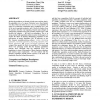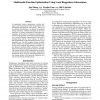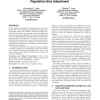116
click to vote
SOCO
2010
Springer
14 years 7 months ago
2010
Springer
In this paper, a diversity generating mechanism is proposed for an Evolutionary Programming (EP) algorithm that determines the basic structure of Multilayer Perceptron classifiers ...
100
click to vote
GPEM
2010
14 years 11 months ago
2010
Abstract With current developments of parallel and distributed computing, evolutionary algorithms have benefited considerably from parallelization techniques. Besides improved com...
103
Voted
SAC
2008
ACM
14 years 12 months ago
2008
ACM
Biological populations are dynamic in both space and time, that is, the population size of a species fluctuates across their habitats over time. There are rarely any static or fix...
158
Voted
FOGA
1998
15 years 1 months ago
1998
Genetic algorithms (GAs) are multi-dimensional and stochastic search methods, involving complex interactions among their parameters. For last two decades, researchers have been tr...
101
Voted
FLAIRS
2003
15 years 1 months ago
2003
Researchers studying Evolutionary Algorithms and their applications have always been confronted with the sample complexity problem. The relationship between population size and gl...
130
click to vote
FLAIRS
2004
15 years 1 months ago
2004
In multimodal function optimization, niching techniques create diversification within the population, thus encouraging heterogeneous convergence. The key to the effective diversif...
89
Voted
GECCO
2006
Springer
15 years 4 months ago
2006
Springer
The population size in evolutionary computation is a significant parameter affecting computational effort and the ability to successfully evolve solutions. We find that population...
GECCO
2006
Springer
15 years 4 months ago
2006
Springer
In an evolutionary algorithm, the population has a very important role as its size has direct implications regarding solution quality, speed, and reliability. Theoretical studies ...
116
Voted
GECCO
2003
Springer
15 years 5 months ago
2003
Springer
Abstract. Population size for EvolutionaryAlgorithms is usually an empirical parameter. We study the population size from aspects of fitness landscapes’ ruggedness and Probably ...
GECCO
2003
Springer
15 years 5 months ago
2003
Springer
With the exception of a small body of adaptive-parameter literature, evolutionary computation has traditionally favored keeping the population size constant through the course of t...



